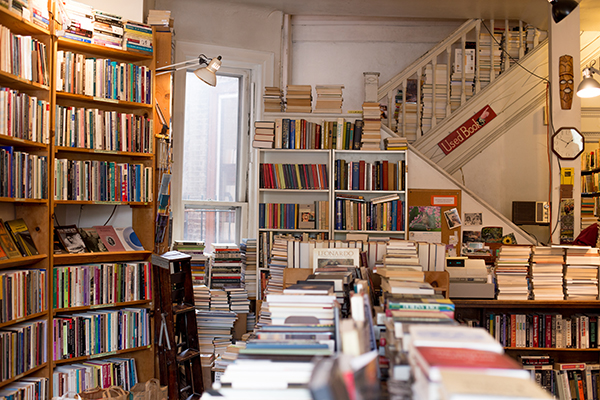Photo by Margo Reed
Open House
by Emily Kovach
When you step into House of Our Own, you first notice the sheer quantity of books, and the echo of history in the space. It is indeed a house, squeezed between University of Pennsylvania fraternities on Spruce Street, resplendent with Victorian architecture details: high ceilings, arched doorways, leaded glass windows and crown moldings. And the books: thousands and thousands of books, organized in floor-to-ceiling shelves. This many books could feel overwhelming, but in here it doesn’t. The titles are lovingly (perhaps obsessively) organized into sections and subcategories so nuanced that browsing becomes a guided journey. The atmosphere is serene, yet still lively. Immersed in literature and an easy quietude, the mind is free to wander, explore and dream.
This was precisely the goal of owner Debbie Sanford when she and an ex-partner opened House of Our Own in 1971. Sanford, a UPenn transfer student from a music conservatory in Boston, was an anti-Vietnam War activist on campus and sensed that while social justice work energized her community, it also deeply stressed them out. “We perceived a need for some level of comfort for people who were activists. They need[ed] time to think, relax and expand their minds,” she says. The building, rented from the university and renovated by Sanford, her friends and supportive faculty, was originally a bookstore on the first floor and a crafts space on the second floor.
In the decades since, the shop has transitioned to just a bookstore and draws customers from both in and outside the university. Sanford and her husband, Greg Schirm, are the proprietors and have a deep knowledge and pride in the depth and breadth of their stock. While there is a bent to the political left of many of the titles they offer, Sanford insists they are not a politics-only bookstore. The fiction and poetry sections—mostly used books—are expansive, as are the shelves dedicated to literary criticism, fine arts, film, architecture and many of the other humanities and social sciences.
“The overall tenor is scholarly, but we carry books people are interested in… we are not pretentious,” Sanford says. “I see kitchen workers from the hospitals browsing alongside Penn professors.” It is this balance of the academic and the populist, combined with the creaky-floorboard vibe of the house and the unwavering dedication of its owners, that’s helped them survive the rise of chain bookstores, Internet books sales and e-books.
The sensory, textural experience of the shop is also part of Sanford’s focus, which she credits to her training as a classical pianist. “I have an inherent sense of organization and keep at things until they’re correct with an aesthetic sense,” she says. “I want the books to pull people in.” She tells the story of a young woman who walked in and stood in the doorway in disbelief. Sanford recalls: “She said she’d never been in a bookstore besides Barnes and Noble… I’ll never forget the expression of awe on her face.”








